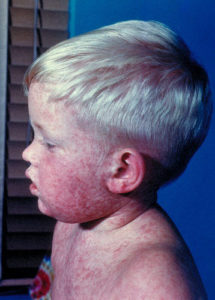WESTON, FL – February 20, 2024 – A cluster of 6 measles cases was first reported on February 16th at the Manatee Bay Elementary School, a public school in Broward County, near Miami. The CD reported that as of February 23rd, there have been at least 35 cases in 15 states this year. Widespread measles vaccination since 1963 has nearly eliminated the disease in the U.S. 3-4 million Americans had measles annually before the vaccine, according to the CDC. Nearly every child got measles by the time they were 15 years old, including myself. Fewer than 200 cases a year have been reported in the U.S. between 1997 and 2013. More than 200 cases a year occurred in only 3 years out of the next 10.
Measles is a highly contagious virus that can spread through airborne droplets when an infected individual sneezes or coughs. The droplets can remain in the air for up to 2 hours. The onset of symptoms can occur 8 to 14 days after exposure. Measles is recognized by a rash on the face and neck appearing 3-5 days after symptoms begin. The rash can spread to the rest of the body. Signs and symptoms include: a high fever, cough, runny nose, and red, watery eyes. 20% of infected unvaccinated children require hospitalization. The virus spreads between 4 days prior and 4 days after the rash appears. The illness can cause permanent hearing loss, intellectual disability after brain swelling, and respiratory complications after pneumonia. Fatalities occur in about 1% of hospitalized persons.
The risk of contracting measles is very low in persons who had the illness or have been vaccinated. The measles vaccine has become a part of the Measles, Mumps, Rubella (MMR) vaccine since 1971. The MMR vaccine is given as a series of 2 doses. The first dose is at 12 to 15 months of age. The second dose is at 4 to 6 years of age. After 2 doses, 98% of people are protected against getting infected with measles; therefore, the infection is almost completely preventable. Vaccination is done before a child enters kindergarten in the U.S. The CDC has recommended a 95% vaccination rate to achieve herd immunity. However, the CDC reports that the vaccination rate has dropped in the U.S. since the COVID-19 pandemic because an increased number of exemptions have been obtained by parents.
Up to 90% of unvaccinated persons who have never had measles before will become infected if they are exposed to a person with measles. Measles outbreaks in the U.S. can occur from international travelers who get measles in nations with a low vaccination rate. Upon return, the infection can spread to unvaccinated people and to communities with low vaccination rates. The Broward County School Superintendent reported on February 21st that 97% of the students at the Manatee Bay school have been vaccinated, above the U.S. target. At this time, it has not been determined whether the infected students had been vaccinated or not.
Few adverse reactions arise from the measles vaccine. Children can develop fever, tiredness, and a rash 10% of the time, and joint pain 3% of the time. Severe reaction rarely occurs after vaccination, in about 3 out of 1 million people. Numerous peer-reviewed studies have shown no association between the vaccine and autism.
Dr. Michael Osterholm, director of the Minnesota’s Center for infectious Disease Research and Policy said, “We’re going to see more kids seriously ill, hospitalized and even die. And what’s so tragic about this, these are all preventable.”
Listen to the full report below:
Contact: Dr. Dick Needleman, Health reporter, 103.3 AshevilleFM, [email protected]
More Posts for Show: Asheville FM News Hour
